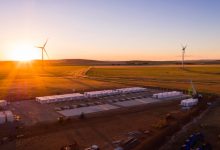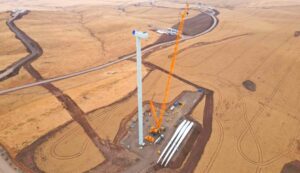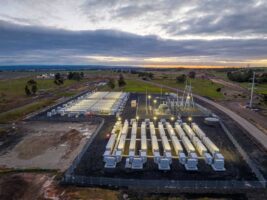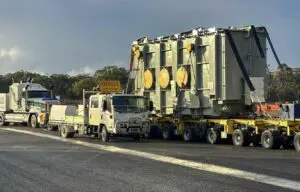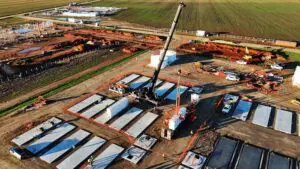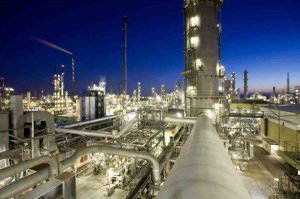French renewable energy developer Neoen has filed its development application for the huge $3 billion Goyder South wind, solar and storage project in South Australia which includes a proposed big battery than it nearly 10 times bigger than the expanded “Tesla big battery” at Hornsdale.
The plan proposes a total of 1,200MW of wind energy, 600MW of solar PV, and 900MW/1800MWh of battery storage, an “extremely large” battery as Neoen describes it that will dwarf the 150MW/194MWh “Tesla” battery known officially as the Hornsdale Power Reserve.
Each stage would be delivered in three equal tranches of 400MW wind, 200MW solar and 300MW/600MWh of battery storage. Combined, they would generate around 4.8 terawatt hours of zero emissions power each year, nearly doubling the current output of wind and solar in the state, and taking South Australia close to the Liberal government’s net 100 per cent renewables target just on its own.
Neoen insists that the first stage is likely to go ahead regardless of any significant grid upgrades, but admits that the second and third stages would be contingent on the new transmission line between South Australia and NSW, known as Project EnergyConnect, going ahead. It will be located south of Burra, and north of Robertstown, where the new transmission link is expected to link to the state grid.
“The Goyder region in South Australia is home to some of the best wind and solar resources in the country,” the company says in its application.
“The Goyder South Hybrid Renewable Energy Facility is proposed to take advantage of these resources by combining wind, solar and energy storage in one integrated project. The facility will be capable of delivering a steady, reliable, dispatchable output of power throughout the day and night.”
Neoen says the wind facility will be made up of up to 163 turbines, suggesting a capacity of 7.3MW per turbine – by far the biggest announced in Australia to date. It says these machines will have a maximum hub height of 160m, a maximum blade length of 80m and an overall maximum height (tip height) of 240m.
The solar farm would be spread across 3,000 hectares, the lithium-ion batteries would deliver 900MW with two hours of storage, and associated infrastructure for connection to the electricity grid would include three substations, access tracks, underground connection cabling and transmission lines.
Neoen says the “extremely large battery” associated with the proposed project would be located on the South Australia end of the future EnergyConnect line and would, like the Hornsdale Power Reserve, provide crucial grid support functions to thestate????s energy supply.
“It would be available to assist the grid in the event of major disruptions,” it says, noting the key role that Hornsdale and other big batteries played in keeping South Australia’????s grid stable during the recent disruption to one of its major links to Victoria.
“The battery????s key role, however, would be to allow Goyder South to provide ????hedge???? contracts to consumers such as industrial customers or electricity retailers,” it says.
“These contracts guarantee customers a fixed power price 24 hours a day, irrespective of regional spot price fluctuations. This reduces the risk of power price fluctuations to large, energy-intensive industries and businesses such as mines, smelters, manufacturers and retailers.
It says the hedge contract market has previously been occupied exclusively by fossil fuel generators. “Goyder South would be able to provide these contracts at a much lower cost, and without the emissions, environmental damage and exposure to international fuel prices associated with gas generators.
“By combining energy production and storage, Goyder South would overcome the conventional critique of renewables that they are ????intermittent???? and ????unreliable????. Hybrid projects such as this are the natural ????next step???? in the transition to a cleaner, cheaper, renewable economy.”
State energy minister Dan van Holst Pellekaan noted that the project’s “powerful battery would also be able to support the stability of the interconnector and provide bulk volume emergency power to South Australian consumers in the event of disruptions to interstate supply.”
 Neoen says wind in this region tends to blow most strongly at night, while solar is, of course, present during the day. The resulting energy output, firmed and smoothed by battery storage, would be able to closely match South Australia????s average consumption profile.
Neoen says wind in this region tends to blow most strongly at night, while solar is, of course, present during the day. The resulting energy output, firmed and smoothed by battery storage, would be able to closely match South Australia????s average consumption profile.
The battery would likely charge during the day, absorbing much of the solar output, and already during the early morning, powered by wind. It would discharge mostly in the late afternoon and evening.
Neoen says wholesale prices have fallen dramatically over the last year, but to keep them low, renewables and storage will need to replace gas generation, whose costs can be expected to rise again.
“In summary, Goyder South would be expected to produce up to 4,800,000 MWh per year of low-cost renewable generation, while also introducing battery storage that is able to replace the grid-support functions of gas generation,” it says.
“This would continue to put downward pressure on electricity pricing for all consumers in the state and provide opportunities to support new and existing businesses to remain competitive nationally.”
Given the scale of energy generation that would ultimately be achieved by development of the Goyder South project, it is proposed to be constructed in multiple stages, the company says.
“It is not yet possible to be certain about the size and composition of each stage as this depends on the size and type of the demand from electricity customers.”

It would likely take three years from the date of approval for construction to commence, and another three years for the first stage to finish. Subsequent stages, depending on demand from customers, would likely only commence three years after the start of construction for the previous stage – meaning the whole project may not be complete until 2032.
The project area encompasses the ranges and plains between the Barrier Highway and the Goyder Highway, over approximately 30,000 hectares and various land parcels, spanning a distance of 27km from the south and south- west of Burra (starting 5km from the town centre) to north of Robertstown.
Submission on the project, which goes before the State Commission Assessment Panel, are due by September 18.

